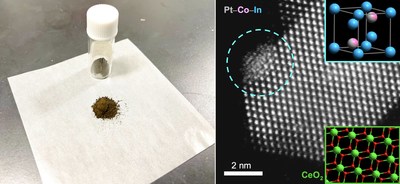Subjects: PDT, SVY
New, highly efficient catalyst for propylene production developed by Hokkaido University
HOKKAIDO, Japan, Jan. 28, 2022 /PRNewswire/ -- Propylene is a colourless, flammable hydrocarbon gas that is an important raw material for the production of a variety of petrochemicals. Due to increasing demand and limited global supply, there is a strong need to develop new, efficient technologies for its production.
Researchers at Hokkaido University have developed an innovative catalyst for the production of propylene that is highly active, selective, stable and utilizes carbon dioxide (CO2) efficiently. Their findings were reported in the journal Nature Catalysis.
One promising technique for producing propylene is a chemical reaction, called oxidative dehydrogenation, that uses CO2 to convert propane gas into propylene by removing hydrogen. However, existing catalysts used to speed up this chemical reaction aren't very efficient.
"The challenge is to develop a catalyst that will activate both reactants ? propane and CO2 ? without unwanted side reactions. It also needs to be stable and reusable in the long term," explains Hokkaido University molecular engineer, Shinya Furukawa.
To achieve this, Furukawa and his colleagues developed a catalyst made from three different metals (platinum, cobalt and indium), each chosen for its specific properties. Platinum was selected as the main active metal because of its ability to break chemical bonds between carbon and hydrogen, enabling the dehydrogenation reaction. Cobalt accelerates CO2 capture and activation, while indium enhances the catalyst's selectivity. The metals were fixed to a support made from cerium oxide, a compound commonly used in car catalytic converters.
The researchers tested the catalyst's activity at 550°C and compared the results with existing catalysts. They also performed a mechanistic study to understand the functions of the different components and found the catalyst links the propylene-forming reaction to the deoxygenation of CO2, and ensures the catalytic activity is specific to propane; water and carbon oxides are formed as byproducts. Further, they found that the catalyst increased the reaction rate approximately five fold compared to the typical values reported from other systems. The reaction produced a higher ratio of propylene and utilized more CO2 at 550°C compared to previous catalysts. The catalyst also showed good long-term stability and reusability.
"To date, no other catalyst has been shown to simultaneously exhibit a high catalytic activity, selectivity, stability, and CO2 utilization efficiency. Our multifunctional material meets all these requirements," says Furukawa.
This study provides new insights into the design of highly efficient catalysts for petrochemical production, and has potential benefits for carbon recycling and greenhouse gas reduction.
Contacts:
Associate Professor Shinya Furukawa
Institute for Catalysis
Hokkaido University
Tel: +81-11-706-9162
Email: furukawa[at]cat.hokudai.ac.jp
Sohail Keegan Pinto (International Public Relations Specialist)
Public Relations Division
Hokkaido University
Tel: +81-11-706-2185
Skype: hokudai.pr1
Email: en-press[at]general.hokudai.ac.jp
Original Article:
Feilong Xing, et al. Platinum?cobalt?indium nanoalloy on ceria as a highly efficient catalyst for the oxidative dehydrogenation of propane using CO2. Nature Catalysis. Month DD, 2021.
DOI: 10.1038/s41929-021-00730-x
Related Press Releases:
'Double decoration' enhances industrial catalyst
Ultrastable, selective catalyst for propane dehydrogenation developed
Funding:
This work was supported by the Japan Society for the Promotion of Science (JSPS) KAKENHI (17H01341, 17H04965, 20H02517); the Ministry of Education, Culture, Sports, Science and Technology (MEXT) project Element Strategy Initiative (JPMXP0112101003); Japan Science and Technology Agency (JST) Core Research for Evolutional Science and Technology (CREST; JPMJCR17J3) and Precursory Research for Embryonic Science and Technology (PRESTO; JPMJPR19T7); and the Collaborative Research Projects of Laboratory for Materials and Structures, Institute of Innovative Research, Tokyo Institute of Technology. The XAFS analysis was performed with the approval of JASRI (No. 2019B1620 and 2019B1469).
Photo - https://mma.prnewswire.com/media/1729661/Hokkaido_University.jpg
SOURCE Hokkaido University
These press releases may also interest you
|
News published on and distributed by:




